
Biome in North America: Quick look
|
Introduction
A biome is a group of organisms with almost the same characteristics living together in a large area of the earth. There are different types of biomes seen in North America. These are temperate deciduous forests, desert biomes, grassland biomes, tundra biomes, coastal biomes, mountain biomes boreal forests, etc. All these biomes are discussed in detail below.
There are five regions in North America.
- These are the Great Plains
- Canadian Shield
- Mountains east
- The Caribbean
- Varied eastern regions.
These regions include all the major types of biomes in the world. Ecosystem patterns within each biome reflect variability in climate and soil elemental composition combined with human activities that have increased in scope and intensity over the past several centuries.
Diverse biota can be observed in all these North America biomes. Different species of flora grow in all these regions. All of these biomes in North America are home to a variety of species. So the climatic characteristics, flora, and fauna of all these biomes are discussed here (1) & (5).
Boreal Forest: The Northern Coniferous Biome
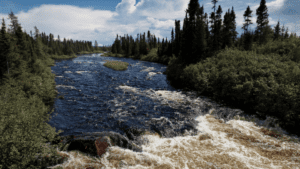
Geographical distribution
In North America, the boreal forest extends across the surface of Canada and Alaska. The northern part of the United States also has boreal forests. In the United States, it is known as Northwood.
Interesting facts
- Boreal forests are the largest terrestrial biome in the world. It covers about 11% of the earth’s land mass.
- This forest also extends across Sweden, Finland, northern Norway, Russian Siberia, and the northern part of Kazakhstan, Mongolia, and Japan.
- One-third of the world’s trees are in boreal forests.
- Boreal forests are full of deciduous trees and conifers. White spruce, jack pine, black spruces, fir, birch, trembling aspen, etc. are shown here. The most common deciduous trees found in the boreal forest are white birch and trembling aspen.
- More than 85 species of mammals, 100 species of fish, 20,000 species of insects, and 300 species of birds are noticeable in this forest. Beaver, moose, brown bear, reindeer, American beaver, bears, red fox, wood bison, martens etc. are shown here (3) & (5).
Temperate Deciduous Forest: The Iconic Forest Biome
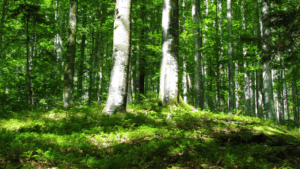
Geographical distribution
Temperate deciduous forests are found in the eastern part of the United States and Canada, Europe, and parts of China and Japan.
Interesting facts
- The temperate deciduous biome is the second largest biome on the earth’s surface. It covers about 21% of the world’s forest area.
- The average daily temperatures in this biome range between -20°C and 20°C. And yearly average temperature is about 10°C.
- It receives about 500 to 1000 mm of rain per year.
- A variety of trees, shrubs, and bushes grow here. Most trees are broadleaf trees such as oak, maple, beech, hickory, and chestnut. Mountain laurel, azalea, and mosses are also found in this biome. These plants live on the shady forest floor where only a small amount of sunlight gets through.
- Various types of insects, spiders, slugs, frogs, turtles, and salamanders are found here. Raccoons, white-tailed deer, broad-winged hawks, cardinals. Snowy owls, woodpeckers, opossums, porcupines, red foxes, etc. can be noticeable in this biome.
- Four seasons are observed in temperate deciduous forests: winter, spring, autumn, and summer. In autumn, the leave’s color changes. Leaves fall in winter and return in spring. And summer is very hot (2) & (6).
Grassland Biomes: Prairies and Plains of North America
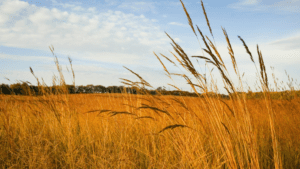
Interesting facts about the grassland biome
- Grasses are the most important plants in this biome.
- There are three major types of grassland found in North America. These are the great plains of the Midwest, the Palouse prairies of eastern Washington State, and other grasslands of the Southwest.
- Temperatures exceed 37.8°C in the grassland biome.
- Rainfall in grasslands usually occurs in late spring and early summer.
- The annual average is about 20-35 inches, but most of this falls as snow in the winter.
- Trees and large shrubs are rarely found in grassland areas. There are many species of grasses living in this biome, including purple Nile grass, wild oats, foxtail, ryegrass, and buffalo grass.
- Gazelles, zebras, rhinoceroses, wild horses, lions, wolves, prairie dogs, jackrabbits, deer, mice, coyotes, foxes, sparrows, hawks, owls, snakes, grasshoppers, leafhoppers and spiders, etc. are found in grassland biome (4).
Desert Biomes: Arid Landscapes in North America

- Desert biomes are the driest of all the biomes.
- There are mainly four major desert biomes in North America. These are Great Basin, Mohave, Chihuahuan, and Sonoran.
- These biomes receive less rainfall, less than 30 cm.
- Here temperatures vary greatly between day and night.
- At night, desert temperatures fall to an average of -5°C.
- Saguaro, ocotillo, chain fruit cholla, teddy-bear cholla, apricot mallow, desert ironwood, etc. plants can be seen here.
- Peccaries, ringtails, gila woodpeckers, mule deer, coyotes, bighorn sheep, black-tailed and jackrabbits, etc. are found in desert biomes in North America (2).
Tundra Biome: Extreme Cold Environments
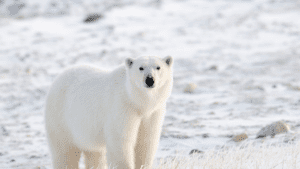
- The Tundra biome of North America is situated in parts of northern Canada the coast of Greenland and some parts of Alaska.
- This biome is home to some frost-tolerant plants and animals, mainly in extreme cold environments.
- Organisms developed above the tree line in the tundra mountain region and the high latitude snow circle.
- It belongs to the permafrost area.
- The average annual temperature is lower than 4°C.
- The temperature here is below 0°C for nine months of the year.
- Rainfall is very low in the tundra biome. The average annual rainfall is less than 30 cm.
- The main soils of this region are gray lithoshal soils.
- About 3% of the world’s plant species belong to the tundra biome.
- Juniper, willow, birch, alder, valerian, etc. are grown here. Small grasses like moss, algae, and lichen also grow in relatively cool areas.
- About 100 species of Polar bear, wild yak, snow leopard, stoat, red fox, Tundra swan, bald eagle, snowy owl, snow petrel, cape petrel, etc. are seen here (5).
Coastal Biomes: Mangroves, Estuaries, and Salt Marshes
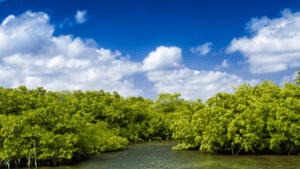
- Mangrove forests are found along coastlines and estuaries, typically in tropical coastal areas between 32°N and 38°S in North America.
- These biomes are shallow and nutrient-rich.
- Mangroves provide shelter for young fish, shrimp, crabs, and mollusks where they can safely live and develop.
- This biome provides habitat for more than 500 species of birds.
- The Chesapeake Bay is the largest estuary in North America. It is the home of more than 3000 plants and animals.
- Smooth cordgrass, purple loosestrife, seagrass, Salix, sea lavender, etc. are some plants of the coastal biome.
- The salt marsh is one of the important coastal biomes. These are found mainly on every coast
- Peat soil is found here.
- Gray whales, Canada goose, yellow-rumped warbler, giant sea bass, coral, etc. are the habitat for coastal animals (2) & (4).
Mountain Biomes: Alpine and Subalpine Ecosystems
Alpine

Alpine region is a type of natural region Due to high altitude, no trees grow here. The altitude creates an unfavorable climate here. The vegetation of this region is characterized by dwarf bush plants close to the ground. Here, the average summer temperature is around 10°C. In winter the temperature is below freezing. Sedges, Forbes, cushion plants, mosses, lichens, some types of grasses (perennial grasses), etc. are found in the alpine region. Alpine chough, large parrot, marmot, mountain goat, bighorn sheep, Himalayan tahr, yak, snow leopard, etc. are found here.
Subalpine

Subalpine is the biome below the tree line in the rocky mountains of North America. This zone elevations from 9000 to 12,000 feet in northern New Mexico. This zone extends from 1500 to 2500 m in north Alberta, in North America. The subalpine climate never warms. It can snow any day of the year. The temperature in summer is around 24° C and winter temperature is about -10°C.
Subalpine fir and Engelmann spruce are more prominent in this region. In other areas, Engelmann spruce and subalpine fir are found along with various pines, limber pine, whitebark pine, and bristlecone pine, other types of firs such as Douglas-fir and silver fir, and various junipers. Because of the extreme cold and lack of food sources, the subalpine region limited native animal species. Bears and cougar subalpine, lynx, snowshoe hare, American marten, and various squirrels can be seen here. Also, some birds, such as the mountain chickadee and Steller’s jay, are commonly found in this region (2).
Q&A
1. What are the 7 biomes of North America?
Temperate deciduous forest, desert biomes, grassland biomes, tundra biomes, coastal biomes, mountain biomes, and boreal forest.
2. What is the most common biome in North America?
The temperate deciduous forest biome is the most common biome in North America.
3. What are the 3 main biomes found in us?
Temperate deciduous forests, Desert forests, and grassland biome are the 3 main biomes found in us.
Written By: Manisha Bharati
